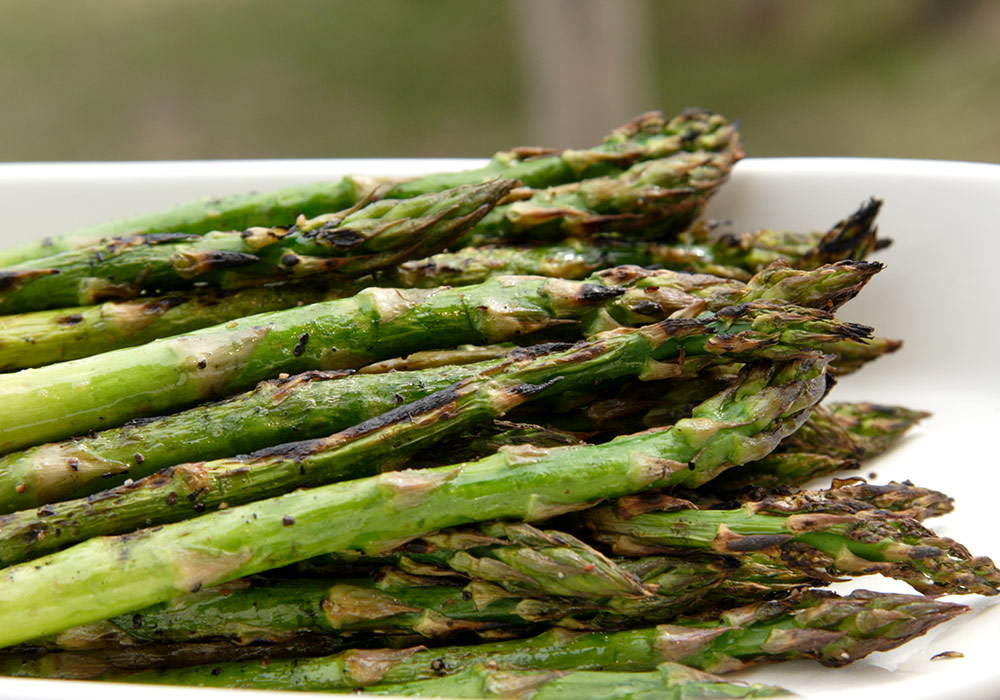
Celebrate Spring with these four recipes to help you embrace the new season!
Spring is my favorite time of the year. After the long cold, dark winter, the extra sunshine makes me so very happy. And spring also means that fresh vegetables are bursting with flavor! Here are four of my favorite spring recipes, ranging in difficulty from simple to spectacular!
Roasted Asparagus (very easy)
Ingredients:
- One bunch of asparagus – buy stalks that are bright green and medium thickness.
- Extra virgin olive oil to drizzle
- Flaky sea salt to taste

- Wash asparagus under cold water and snap off the woody ends.
- If you’d really like to, you can peel them. Start below the floret and peel down towards the base (to be honest – if the asparagus is fresh and local, I don’t bother peeling)
- Put on a sheet pan or into a shallow Pyrex baking dish.
- Drizzle with extra virgin olive oil and sprinkle with flaky sea salt
- Put into a 400-425 degree oven for 20-25 minutes, shaking the pan about halfway through to ensure they aren’t sticking.
- Remove from the heat when they are nicely roasted and beginning to brown
- Enjoy immediately or serve at room temperature

Sautéed Spinach (moderately easy)
Ingredients:
- Spinach – about 2lbs
- Extra virgin olive oil – about ¼ cup
- One clove garlic
- Flaky sea salt and red pepper flakes to taste
- 1-2 tbsp of fresh squeezed lemon, lime, or orange juice

This is a two part recipe, each part taking about 10 minutes. Part one can be done earlier while you’re prepping other parts of your meal and the wilted spinach can continue to drain in the colander until you’re ready to fire it – which will also take less than 10 minutes.
Part one: cover the base of a large pot with a thin layer of water – about ½ a cup or so (I use the same pot I use to boil water for pasta). Cover and heat over moderately low heat (4 on a 10 point scale) until steam starts to form under the lid.
Add a good amount of spinach (about 2 lbs) and cover. Turn with tongs once or twice until it’s all nicely wilted – about 10 minutes. (It will reduce in size quite dramatically.)
Carefully remove the wilted spinach from the pot and put it into a colander to drain.
Once it’s cool enough to handle – you can roughly chop it on a cutting board – or even better – use kitchen scissors to slice it up right in the colander (so you don’t need to wash the green juice off the cutting board).
Part two: cover the bottom of a large sautée pan with extra virgin olive oil and add a minced clove or two of garlic. Heat over moderately low heat until the garlic becomes aromatic and begins to sizzle.
Once you can smell the garlic, set a timer for one minute and let it sizzle away, stirring occasionally.
When the timer goes, add the drained and chopped spinach, a nice pinch of flaky sea salt, and red pepper flakes to taste (optional – some people don’t like them – but I love them). Sautée, stirring occasionally, for about three minutes, until the spinach is bright green and nicely heated through (it will steam a bit).
Remove the sautéed spinach from the pan into a serving plate or bowl to get it off the heat. Drizzle with a bit (1-2 tbsp) of freshly squeezed citrus juice (lemon, lime, or orange work well). Enjoy immediately!

Arugula Pesto (more complex)
Ingredients:
- Two handfuls of arugula
- 2-3 tbsp pine nuts
- ½ cup freshly grated parmigiano reggiano
- Flaky sea salt and freshly ground black pepper to taste
- Extra virgin olive oil – about ½ cup

This is a wonderful alternative to basil based pesto and it has the slight peppery quality of arugula – which goes wonderfully with pasta (or spread on toasted bread to make a quick crostini)!
In the base of a food processor, add a few tablespoons of pine nuts and a couple of handfuls or arugula. Add about ½ a cup of freshly grated parmigiano reggiano and a few twists of freshly grated black pepper.
While the motor is running, slowly drizzle in extra virgin olive oil until the mixture forms a thick paste. It’s important to add the oil while the machine is running so that it combines nicely and emulsifies. It’s better to under do the oil – you can always add more.
When a nice paste begins to form – stop the machine and scrape down the sides with a spatula. If it’s too thick and chunky, start it up again and add a bit more extra virgin olive oil. Once it gets to the visual consistency you’d like, taste it and adjust the seasoning. It will likely need a little flaky sea salt. You might also want to add a bit more parmigiano reggiano (which will also increase the saltiness).
When it’s done… put some at the bottom of a large pasta bowl. Cook your pasta in boiling salted water according to the directions. IMPORTANT: don’t dump the pasta and water into a colander. Instead – when it’s perfectly al dente, scoop it out of the boiling water with a sieve or strainer and put it into the bowl with the pesto, allowing some of the water to cling to it (this water will be very starchy and will actually allow your pesto to thicken). Stir and add more pesto if necessary. Top with additional grated parmigiano reggiano and freshly grated black pepper to taste.

We’d love to see how you do with these recipes! Just simply snap a pic, post it on social and tag me, @mybobs for a chance to be featured in my feed!